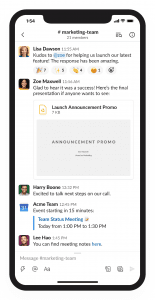Leverage the Power of Internal Networking to Land a Job

So you’ve been hearing a lot about networking to find a job. Before you get skeptical of talking to strangers… why not network with the people in your own company? Enter the surprisingly simple power of internal networking.
By: Jennifer Meehan | Contributor for Let’s Eat, Grandma
Hands down, networking is the best way to find a job. According to multiple sources, some 70% of jobs are never publicly posted and a whopping 80% of all jobs are filled through personal and professional connections. Exact percentages may vary, but just about every statistic and every job search expert will agree — most jobs are filled through networking.
Particularly in an uncertain job market, who you know can make the difference between getting the job you want or settling for something else.
Want more job search tips? Sign up for our newsletter!
What we know as “networking” has been acknowledged forever as the way to get your foot in the door, although the term was first used in 1967. With the advent of LinkedIn, millions of job seekers were able to communicate with others in their field and build connections with professionals across the world. Getting active on LinkedIn with a good profile is as essential as writing a good resume for job seekers today.
Building authentic relationships with other professionals can quickly lead to a job at their company. But does the idea of reaching out to strangers sound intimidating to you? Good thing that’s not all that networking is.
“Networking” is often thought of as a fancy word for schmoozing with random people, but a big part of effective networking is simply building connections with people you already know. In fact, it can start in your current company.
Opportunity Awaits: Land a Job with “Internal Networking”
There are uniquely personal relationships you can form with internal networking. This means connecting with people at your current job who might be able to help you find promotion opportunities, connect you with their contacts in other companies you want to work for, or simply improve your visibility.
By starting with getting to know people in your current work environment, you’ll easily expand your network for when you need a new opportunity. You’ll have a broader base of people who can honestly say “this person would be a great hire” when referring you to someone.
Internal networking is about more than making friends at work. You’re probably friendly with a few people in your department — at least we hope you are. But forming a network involves going beyond your closest coworkers to form relationships with others who are in a different department or subject matter area.
For example, if your job is marketing financial products like annuities and life insurance, get to know the mutual fund marketing team. Asking about their jobs will give you some insights into your own area. Maybe you could use some of their strategies for acquiring new clients. And you’ll learn something about mutual funds, which will be useful if you’re looking for a promotion or a lateral move into overall financial marketing in the company.
It’s Just Lunch

The simple act of getting lunch or coffee with your coworkers can broaden your base of connections for your next job. (Photo by Helena Lopes on Unsplash.)
Ideally, your company will provide opportunities in the way of informal lunch meetings among several departments or mini-seminars with subject experts.
Unfortunately, not all companies are so enlightened. We once heard about a medium-sized company that never held staff meetings or even provided a space where the employees could gather to share news, like the proverbial water cooler.
In fact, it actively discouraged such informal conversations between coworkers and silence reigned.
In this case, a few employees bucked the old company culture and started going out to lunch together once a week. In a while, people from other departments joined them. Interspersed among the discussions of current TV shows was work information. An employee who was focused on a single product could learn about other projects and get a feel for where the company was headed. So, what felt like a dead-end job opened up to other possibilities.
The simple act of sharing a lunch hour made a big difference in the work environment. Eventually, the company even installed a coffee maker!
Getting to know you…
Internal networking can increase satisfaction with your job, help you understand the company dynamics, and make valuable connections for future jobs.
Here are some tips for meeting coworkers:
• Introduce yourself.
You see the same person day after day in the halls or the restroom, each of you smiles and says a quick “Hi”. That’s it. End of interaction. You probably don’t know what department they’re in, much less what work they do.
Next time say, “I keep seeing you and I realized we don’t know each other’s names. I’m Jennifer in Operations. Where do you work?” Chances are, they’ve been feeling a little awkward too. Maybe they work in a department you’ve been dying to get your foot into.
I once held a job in the alumni department of medical school and actually had my eye on a better position with the school magazine. Over a few days, I noticed that the editorial team ate lunch together in the cafeteria a couple of days a week. I sat at a table next to theirs and eventually contributed to their conversation, offering some details about my writing background. The next time an opening came around, I was one of the first applicants they talked to!
• Start “slacking off.”
Is your company still working remotely due to the COVID-19 pandemic? (Or maybe you’ve always been remote.) Take full advantage of whatever digital tools they provide for general communication among employees. Slack is especially good for getting to know people. If your company has a Slack, start getting active. There are likely subchannels where you could bond with people who share your interests — and if there aren’t, you can start one! Just be prepared for a lot of GIFs and emoji reactions.
• Walk it over.
Usually in large companies different work teams have their own cluster of cubicles or their own floor. That makes it difficult to interact with anyone in another department. Even if a company encourages internal networking with company-wide functions or team-sharing exercises, it can be hard to break out of your own group of coworkers.
One method for overcoming that (once you’re all back in the physical office) is physically delivering a message to another department rather than sending an email. To take the investment company example, different marketing teams could correspond for months over email and never meet in person. Say a direct marketing brochure needs a sign-off from the assistant director of another team. With the excuse of stretching your legs, print the PDF and walk it over to the other department. While you’re there, pop in on the people you’ve been exchanging email with.
• Ask for help.
Who doesn’t like to offer advice? As a way of getting to know people, asking them to share their expertise is a no-brainer. (This is the same reason why informational interviews are so effective in job searching.) Particularly if you’re a recent hire or starting a new project, asking subject matter experts to explain a new process or product is very valuable.
Say you’re working on an article about gene splicing for the medical school magazine. You could sit at your desk and Google the terms you’re not familiar with. Most of us do just that. Or you could make an appointment with, say, the lab technician who does the splicing. He or she could give you better insights than a website. Besides, they could introduce you to the others in the lab or even ask you for help putting together a paper. Everybody wins.
• Get to know management.
Obviously you’re not going to barge into the president’s office and stick out your hand (maybe, in some companies). But there’s no reason you can’t get friendly with the manager of internal communications or employee affairs, for example. It’s always good to know the decision-makers who can help you get ahead.
Remind yourself that managers are people too. Try to find something you have in common. That automatically elevates the conversation from the usual small talk. Next time you’re in your manager’s office, make a comment about the picture of a dog on her desk: “I love golden retrievers. We had a beautiful one when I was a kid. What’s your dog’s name?” That could lead to a conversation about any number of things.
You might end up talking about her husband’s cool workplace, which happens to be where you have wanted to work forever — I got my dream job that way.
Now, we don’t actually recommend asking your boss to get you a job in another company! But in this case, I had climbed as high as I cared to in my current job. Over a few years, my boss and I had bonded over our love of dogs, sushi, and independent movies. I took my boss to lunch and asked her directly if I could send my resume to her husband at the cool workplace. Within a few months, I had a job there!
Whether your company embraces transparency and communication or is an unfeeling monolith, there are always things you can do to improve your environment. Building personal work relationships is one of the most important things you can do for your own sanity and future job prospects.
Want more job search tips sent straight to your inbox? Sign up for our newsletter here:
Better Resume.
Satisfying Career.
Happier You.

